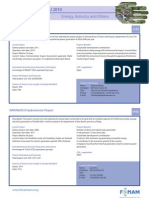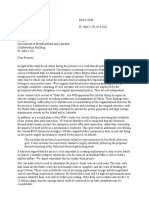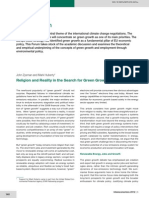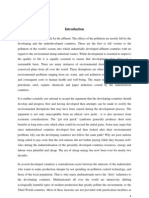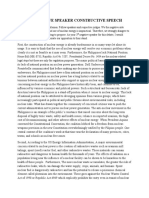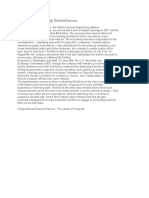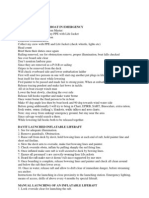Jun 2010 Ques
Jun 2010 Ques
Uploaded by
Emon D' CostaCopyright:
Available Formats
Jun 2010 Ques
Jun 2010 Ques
Uploaded by
Emon D' CostaOriginal Description:
Copyright
Available Formats
Share this document
Did you find this document useful?
Is this content inappropriate?
Copyright:
Available Formats
Jun 2010 Ques
Jun 2010 Ques
Uploaded by
Emon D' CostaCopyright:
Available Formats
Professional Level Essentials Module
Professional Accountant
Monday 14 June 2010
Time allowed Reading and planning: Writing:
15 minutes 3 hours
This paper is divided into two sections: Section A This ONE question is compulsory and MUST be attempted Section B TWO questions ONLY to be attempted Do NOT open this paper until instructed by the supervisor. During reading and planning time only the question paper may be annotated. You must NOT write in your answer booklet until instructed by the supervisor. This question paper must not be removed from the examination hall.
The Association of Chartered Certied Accountants
Paper P1
Section A This ONE question is compulsory and MUST be attempted 1 Hesket Nuclear (HN) is a nuclear power station in Ayland, a large European country. The HN plant is operated by Hesket Power Company (HPC), which in turn is wholly owned by the government of Ayland. Initially opened in the late 1950s, the power station grew in subsequent decades by the addition of several other facilities on the same site. HN now has the ability to generate 5% of Aylands entire electricity demand and is one of the largest nuclear stations in Europe. At each stage of its development from the 1950s to the present day, development on the site was welcomed by the relevant local government authorities, by the businesses that have supported it, by the trade union that represents the majority of employees (called Forward Together or FT for short) and also by the national Ayland government. A nuclear reprocessing facility was added in the 1980s. This is a valuable source of overseas income as nuclear power producers in many other parts of the world send material by sea to HN to be reprocessed. This includes nuclear producers in several developing countries that rely on the cheaper reprocessed fuel (compared to virgin fuel) that HN produces. HPC is loss-making and receives a substantial subsidy each year from the government of Ayland. HPC has proven itself uneconomic but is deemed politically and environmentally necessary as far as the government is concerned. The government of Ayland has reluctantly accepted that large subsidies to HPC will be necessary for many years but considers nuclear power to be a vital component of its energy portfolio (along with other energy sources such as oil, gas, coal, renewables and hydroelectric) and also as a key part of its clean energy strategy. Unlike energy from fossil fuels (such as coal, gas and oil), nuclear power generates a negligible amount of polluting greenhouse gas. HN also provides much needed employment in an otherwise deprived part of the country. The HN power station underpins and dominates the economy of its local area and local government authorities say that the HN plant is vital to the regional economy. Since it opened, however, the HN power station has been controversial. Whilst being welcomed by those who benet from it in terms of jobs, trade, reprocessing capacity and energy, a coalition has gradually built up against it comprising those sceptical about the safety and environmental impact of nuclear power. Some neighbouring countries believe themselves to be vulnerable to radioactive contamination from the HN plant. In particular, two countries, both of whom say their concerns about HN arise because of their geographical positions, are vocal opponents. They say that their geographical proximity forced them to be concerned as they are affected by the location of the HN plant which was not of their choosing. The government of Beeland, whose capital city is 70 km across the sea from HN (which is situated on the coast), has consistently opposed HN and has frequently asked the government of Ayland to close HN down. The Beeland government claims that not only does low-level emission from the site already contaminate the waters separating the two countries but it also claims that any future major nuclear incident would have serious implications for the citizens of Beeland. There is some scientic support for this view although opinion is divided over whether Beeland is being irrational in its general opposition to HN. The government of Ceeland is also a vocal opponent of HN. Ceeland is located to the north of Beeland and approximately 500 km away from Ayland. Some nuclear scientists have said that with such a large stretch of water between the HN plant and Ceeland, even a much-feared incident would be unlikely to seriously impact on Ceeland. Some commentators have gone further and said that Ceelands concerns are unfounded and borne of ignorance. FT, the trade union for HN employees, issued a statement saying that Ceeland had no reason to fear HN and that its fears were entirely groundless. HNs other vocal and persistent opponent is No Nuclear Now (NNN), a well-organised and well-funded campaigning group. Describing itself on its website as passionate about the environment, it describes HNs social and environmental footprint as very negative. NNN has often pointed to an environmentally important colony of rare seals living near the HN plant. It says that the seals are dependent on a local natural ecosystem around the plant and are unable to move, arguing that the animals are at signicant risk from low-level contamination and would have no chance of survival if a more serious radioactive leak ever occurred. NNN points to such a leak that occurred in the 1970s, saying that such a leak proves that HN has a poor safety record and that a leak could easily recur. Each time an objection to the HN power station is raised, FT, the trade union, robustly defends the HN site in the media, and argues for further investment, based on the need to protect the jobs at the site. Furthermore, the radiation leak in the 1970s led to FT uniting with the HPC board to argue against those stakeholders that wanted to use the leak as a reason to close the HN site. The combination of union and HPC management was able to counter the arguments of those asking for closure.
HN places a great deal of emphasis on its risk management and often publicises the fact that it conducts continual risk assessments and is in full compliance with all relevant regulatory frameworks. Similarly, FT recently pointed out that HN has had an impeccable safety record since the incident in the 1970s and says on its website that it is proud that its members are involved in ensuring that the company is continually in full compliance with all of the regulatory requirements placed upon it. The board of HPC, led by chairman Paul Gog, is under continual pressure from the government of Ayland to minimise the amount of government subsidy. Each year, the government places challenging targets on the HPC board requiring stringent cost controls at the HN power station. In seeking to reduce maintenance costs on the expiry of a prior maintenance contract last year, the board awarded the new contract to an overseas company that brought its own workers in from abroad rather than employing local people. The previous contract company was outraged to have lost the contract and the move also triggered an angry response from the local workforce and from FT, the representative trade union. FT said that it was deplorable that HPC had awarded the contract to an overseas company when a domestic company in Ayland could have been awarded the work. The union convenor, Kate Allujah, said that especially in the nuclear industry where safety was so important, domestic workers were more reliable than foreign workers who were brought in purely on the basis of cost and in whose countries safety standards in similar industries might not be so stringent. HPC said that it had done nothing illegal as the foreign workers were allowed to work in Ayland under international legal treaties. Furthermore, it argued that pressure by FT to raise wages over recent years had created, with the governments subsidy targets, the cost pressure to re-tender the maintenance contract. On HNs 50th anniversary last year, NNN published what it called a risk assessment for the HN power station. It said it had calculated the probabilities (P) and impacts (I) of three prominent risks. Risk of major radioactive leak over the next 10 years: P = 10%, I = 20 Risk of nuclear explosion over the next 50 years: P = 20%, I = 100 Risk of major terrorist attack over next 10 years: P = 10%, I = 80 Impacts were on an arbitrary scale of 1100 where 100 was dened by NNN as total nuclear annihilation of the area and thousands of deaths. The governments of Beeland and Ceeland seized upon the report, saying that it proved that HN is a genuine threat to their security and should be immediately closed and decommissioned. HNs risk manager, Keith Wan, vigorously disagreed with this assessment saying that the probabilities and the impacts were ridiculous, massively overstated and intended to unnecessarily alarm people. HNs public relations ofce was also angry about it and said it would issue a rebuttal statement. Required: (a) Distinguish between voluntary and involuntary stakeholders, identifying both types of stakeholders in Hesket Nuclear. Assess the claims of THREE of the involuntary affected stakeholders identied. (12 marks) (b) The trade union, Forward Together, has had a long relationship with HN and represents not only the main workforce but also the employees of the maintenance company replaced by the foreign workers. Required: Explain the roles of employee representatives such as trade unions in corporate governance and critically evaluate, from the perspective of HPCs board, the contribution of Forward Together in the governance of HPC. (10 marks) (c) Explain what an agency relationship is and examine the board of HPCs current agency relationship and objectives. Briey explain how these would differ if HPC was a company with private shareholders. (10 marks)
[P.T.O.
(d) As a part of HPCs public relations effort, it has been proposed that a response statement should be prepared for the companys website to help address two major challenges to their reputation. Required: Draft this statement to include the following: (i) Referring to the NNN report, explain why accurate risk assessment is necessary at Hesket Nuclear. (8 marks)
(ii) Explain what a social and environmental footprint is and construct the argument that HNs overall social and environmental footprint is positive. (6 marks) Professional marks will additionally be awarded in part (d) for drafting a statement that is clear, has a logical ow, is persuasive and is appropriately structured. (4 marks) (50 marks)
Section B TWO questions ONLY to be attempted 2 Five years ago, George Woof was appointed chief executive ofcer (CEO) of Tomato Bank, one of the largest global banks. Mr Woof had a successful track record in senior management in America and his appointment was considered very fortunate for the company. Analysts rated him as one of the worlds best bankers and the other directors of Tomato Bank looked forward to his appointment and a signicant strengthening of the business. One of the factors needed to secure Mr Woofs services was his reward package. Prior to his acceptance of the position, Tomato Banks remuneration committee (comprised entirely of non-executives) received a letter from Mr Woof saying that because his track record was so strong, they could be assured of many years of sustained growth under his leadership. In discussions concerning his pension, however, he asked for a generous non-performance related pension settlement to be written into his contract so that it would be payable whenever he decided to leave the company (subject to a minimum term of two years) and regardless of his performance as CEO. Such was the euphoria about his appointment that his request was approved. Furthermore in the hasty manner in which Mr Woofs reward package was agreed, the split of his package between basic and performance-related components was not carefully scrutinised. Everybody on the remuneration committee was so certain that he would bring success to Tomato Bank that the individual details of his reward package were not considered important. In addition, the remuneration committee received several letters from Tomato Banks nance director, John Temba, saying, in direct terms, that they should offer Mr Woof whatever he wants to ensure that he joins the company and that the balance of benets was not important as long as he joined. Two of the non-executive directors on the remuneration committee were former colleagues of Mr Woof and told the nance director they would take his advice and make sure they put a package together that would ensure Mr Woof joined the company. Once in post, Mr Woof led an excessively aggressive strategy that involved high growth in the loan and mortgage books nanced from a range of sources, some of which proved unreliable. In the fth year of his appointment, the failure of some of the sources of funds upon which the growth of the bank was based led to severe nancing difculties at Tomato Bank. Shareholders voted to replace George Woof as CEO. They said he had been reckless in exposing the company to so much risk in growing the loan book without adequately covering it with reliable sources of funds. When he left, the press reported that despite his failure in the job, he would be leaving with what the newspapers referred to as an obscenely large pension. Some shareholders were angry and said that Mr Woof was being rewarded for failure. When Mr Woof was asked if he might voluntarily forego some of his pension in recognition of his failure in the job, he refused, saying that he was contractually entitled to it and so would be keeping it all. Required: (a) Criticise the performance of Tomato Banks remuneration committee in agreeing Mr Woofs reward package. (10 marks) (b) Describe the components of an appropriately designed executive reward package and explain why a more balanced package of benets should have been used to reward Mr Woof. (10 marks) (c) Construct an ethical case for Mr Woof to voluntarily accept a reduction in his pension value in recognition of his failure as chief executive of Tomato Bank. (5 marks) (25 marks)
[P.T.O.
The Committee of Sponsoring Organisations (COSO) of the Treadway Commission is an American voluntary, private sector organisation and is unconnected to government or any other regulatory authority. It was established in 1985 to help companies identify the causes of fraudulent reporting and to create internal control environments able to support full and accurate reporting. It is named after its rst chairman, James Treadway, and has issued several guidance reports over the years including important reports in 1987, 1992 and 2006. In 2009, COSO issued new Guidance on monitoring internal control systems to help companies tighten internal controls and thereby enjoy greater internal productivity and produce higher quality reporting. The report, written principally by a leading global professional services rm but adopted by all of the COSO members, noted that unmonitored controls tend to deteriorate over time and encouraged organisations to adopt wide ranging internal controls. It went on to say that, the assessment of internal controls [can] ... involve a signicant amount of ... internal audit testing. After its publication, the business journalist, Mark Rogalski, said that the latest report contained yet more guidance from COSO on how to make your company less productive by burdening it even more with non-productive things to do referring to the internal control guidance the 2009 report contains. He said that there was no industry sector-specic advice and that a one-size-ts-all approach to internal control was ridiculous. He further argued that there was no link between internal controls and external reporting, and that internal controls are unnecessary for effective external reporting. Another commentator, Claire Mahmood, wrote a reply to Rogalskis column pointing to the views expressed in the 2009 COSO report that, over time effective monitoring can lead to organisational efciencies and reduced costs associated with public reporting on internal control because problems are identied and addressed in a proactive, rather than reactive, manner. She said that these benets were not industry sector specic and that Rogalski was incorrect in his dismissal of the reports value. She also said that although primarily concerned with governance in the USA, the best practice guidance from COSO could be applied by companies anywhere in the world. She said that although the USA, where COSO is based, is concerned with the rigid rules of compliance, the advice ought to be followed by companies in countries with principles-based approaches to corporate governance because it was best practice. Required: (a) Distinguish between rules-based and principles-based approaches to internal control system compliance as described by Claire Mahmood and discuss the benets to an organisation of a principles-based approach. (7 marks) (b) Mr Rogalski is sceptical over the value of internal control and believes that controls must be industry-specic to be effective. Required: Describe the advantages of internal control that apply regardless of industry sector and briey explain the meaning of the statement, unmonitored controls tend to deteriorate over time. Your answer should refer to the case scenario as appropriate. (10 marks) (c) The COSO report explains that assessment of internal controls [can] ... involve a signicant amount of ... internal audit testing. Required: Dene internal audit testing and explain the roles of internal audit in helping ensure the effectiveness of internal control systems. (8 marks) (25 marks)
Happy and healthy is a traditional independent health food business that has been run as a family company for 40 years by Ken and Stef Potter. As a couple they have always been passionate campaigners for healthy foods and are more concerned about the quality of the foods they sell than the nancial detail of their business. Since the company started in 1970, it has been audited by Watson Shreeves, a local audit rm. Mr Shreeves has overseen the Potters audit for all of the 40 year history (rotating the engagement partner) and has always taken the opportunity to meet with Ken and Stef informally at the end of each audit to sign off the nancial statements and to offer a brieng and some free nancial advice in his role as what he calls, auditor and friend. In these briengs, Mr Shreeves, who has become a close family friend of the Potters over the years, always points out that the business is protable (which the Potters already knew without knowing the actual gures) and how they might increase their margins. But the Potters have never been too concerned about nancial performance as long as they can provide a good service to their customers, make enough to keep the business going and provide continued employment for themselves and their son, Ivan. Whilst Ken and Stef still retain a majority shareholding in Happy and healthy they have gradually increased Ivans proportion over the years. They currently own 60% to Ivans 40%. Ivan was appointed a director, alongside Ken and Stef, in 2008. Ivan grew up in the business and has helped his parents out since he was a young boy. As he grew up, Ken and Stef gave him more and more responsibility in the hope that he would one day take the business over. By the end of 2009, Ken made sure that Ivan drew more salary than Ken and Stef combined as they sought to ensure that Ivan was happy to continue in the business after they retired. During the audit for the year ended 31 March 2010, a member of Watson Shreeves was performing the audit as usual when he noticed a dramatic drop in the protability of the business as a whole. He noticed that whilst food sales continued to be protable, a large amount of inventory had been sold below cost to Barong Company with no further explanation and it was this that had caused the reduction in the companys operating margin. Each transaction with Barong Company had, the invoices showed, been authorised by Ivan. Mr Shreeves was certain Ken and Stef would not know anything about this and he prepared to tell them about it as a part of his annual end of audit meeting. Before the meeting, however, he carried out some checks on Barong Company and found that it was a separate business owned by Ivan and his wife. Mr Shreevess conclusion was that Ivan was effectively stealing from Happy and healthy to provide inventory for Barong Company at a highly discounted cost price. Although Mr Shreeves now had to recommend certain disclosures to the nancial statements in this meeting, his main fear was that Ken and Stef would be devastated if they found out that Ivan was stealing and that it would have long-term implications for their family relationships and the future of Happy and healthy. Required: (a) Explain how a family (or insider-dominated) business differs from a public listed company and, using evidence from the case, explore the governance issues of a family or insider-dominated business. (10 marks) (b) Mr Shreeves is a professional accountant and auditor. Explain why he is considered a professional by society and describe the fundamental principles (or responsibilities) of professionalism that society expects from him and all other accountants. (7 marks) (c) Discuss the professional and ethical dilemma facing Mr Shreeves in deciding whether or not to tell Ken and Stef about Ivans activity. Advise Mr Shreeves of the most appropriate course of action. (8 marks) (25 marks)
End of Question Paper
You might also like
- Branches of AccountingDocument15 pagesBranches of AccountingIsrael Liwliwa75% (4)
- AC316 Chapter 6 & 7 Test Bank Part 2Document30 pagesAC316 Chapter 6 & 7 Test Bank Part 2Nanon Wiwatwongthorn100% (5)
- BSBMGT617 Assessment Task 3 (AT3) Case Study 2Document16 pagesBSBMGT617 Assessment Task 3 (AT3) Case Study 2Nathalia Caroline100% (1)
- Law N Eco Cs 3Document6 pagesLaw N Eco Cs 3Apoorva KudariNo ratings yet
- Governance, Risk and Ethics: Wednesday 11 December 2013Document6 pagesGovernance, Risk and Ethics: Wednesday 11 December 2013shashaclarkNo ratings yet
- Journal of International Economics: Ralph de Haas, Steven PoelhekkeDocument16 pagesJournal of International Economics: Ralph de Haas, Steven PoelhekkeYohana SariNo ratings yet
- Governance, Risk and Ethics: Wednesday 11 December 2013Document6 pagesGovernance, Risk and Ethics: Wednesday 11 December 2013Chessking Siew HeeNo ratings yet
- MootProblem 2017 18Document4 pagesMootProblem 2017 18Shruti BhadoriaNo ratings yet
- Press Releases: Ron Senate CormitteeDocument1 pagePress Releases: Ron Senate CormitteemungagungadinNo ratings yet
- Ontario GVMT - Legitimate Concerns - NRWC Sept 30 2013Document7 pagesOntario GVMT - Legitimate Concerns - NRWC Sept 30 2013mothersagainstwindNo ratings yet
- H53H54Document1 pageH53H54MinamPeruNo ratings yet
- Moot SummaryDocument2 pagesMoot SummarySaravna VasantaNo ratings yet
- A Local To Global Perspective On Oil and Wind Exploitation Resource Governance and Conflict in Northern KenyaDocument31 pagesA Local To Global Perspective On Oil and Wind Exploitation Resource Governance and Conflict in Northern KenyabouciratouthrNo ratings yet
- Governance, Risk and Ethics: Wednesday 11 December 2013Document6 pagesGovernance, Risk and Ethics: Wednesday 11 December 2013Junaid Iqbal MastoiNo ratings yet
- DebateDocument3 pagesDebatepallenevangeleneNo ratings yet
- Property Market Up The Creek, But Top-End Houses With Gold Fittings Continue To Be Snapped UpDocument36 pagesProperty Market Up The Creek, But Top-End Houses With Gold Fittings Continue To Be Snapped UpvietweekNo ratings yet
- OFID Doubles Support To Energy Sector in 2012Document2 pagesOFID Doubles Support To Energy Sector in 2012Rafik ElouardiNo ratings yet
- MOTHBALLED Bataan Nuclear Power PlantDocument14 pagesMOTHBALLED Bataan Nuclear Power PlantLordly LumayagNo ratings yet
- 444 - FukushimaFalloutDocument64 pages444 - FukushimaFallouttatralorNo ratings yet
- 2023 EV Supply ChainsDocument21 pages2023 EV Supply ChainsemtaquebanNo ratings yet
- Moot Propostion - 9th UPES - Dr. Paras Diwan Memorial International Energy Law Moot Court Competition, 2019 PDFDocument8 pagesMoot Propostion - 9th UPES - Dr. Paras Diwan Memorial International Energy Law Moot Court Competition, 2019 PDFShaswatNo ratings yet
- FINAL Kennis - FinalDocument56 pagesFINAL Kennis - FinalVictor OnyekaNo ratings yet
- Macro Example #2Document7 pagesMacro Example #2gr306688No ratings yet
- 60BCLRev387Document27 pages60BCLRev387Septiana MonicasariNo ratings yet
- Out To Sea: The Dismal Economics of Offshore WindDocument30 pagesOut To Sea: The Dismal Economics of Offshore WindManhattan InstituteNo ratings yet
- H45H46Document1 pageH45H46MinamPeruNo ratings yet
- 01 Nuclear Power Is Impossible Without Taxpayer SubsidiesDocument3 pages01 Nuclear Power Is Impossible Without Taxpayer Subsidiesapi-344657102No ratings yet
- P1 Mock Questions 201603Document6 pagesP1 Mock Questions 201603getcultured69No ratings yet
- Watchdog February 1981Document16 pagesWatchdog February 1981Lynda BoydNo ratings yet
- Financing Hydel Power Projects by Mr. Ahad Khan CheemaDocument21 pagesFinancing Hydel Power Projects by Mr. Ahad Khan CheemaJutt AwaraNo ratings yet
- Major Paper 2 RevisedDocument7 pagesMajor Paper 2 RevisedBen LaRocheNo ratings yet
- Research On Wind Power Generation Technology in New Energy Power GenerationDocument7 pagesResearch On Wind Power Generation Technology in New Energy Power Generationdimasbrahmana22No ratings yet
- Solar Power Concept PaperDocument7 pagesSolar Power Concept Paperrasnowmah2012No ratings yet
- BP Oil Spill Research Paper ThesisDocument5 pagesBP Oil Spill Research Paper Thesisnicolekatholoverlandpark100% (2)
- Repurposing of Komati Power Plant - United Front and Centre For Sociological Research and Practice SubmissionDocument4 pagesRepurposing of Komati Power Plant - United Front and Centre For Sociological Research and Practice SubmissionCityPressNo ratings yet
- Document #25-114 BP - CVWF - Comments 12/10/12Document2 pagesDocument #25-114 BP - CVWF - Comments 12/10/12pandorasboxofrocksNo ratings yet
- Article 3Document29 pagesArticle 3gracemghamba8No ratings yet
- Research Proposal For ENG105Document6 pagesResearch Proposal For ENG105Tasnif Mahmud50% (2)
- Dabhol Power Plant Case StudyDocument6 pagesDabhol Power Plant Case StudyAshish Shah0% (1)
- Report of The Joint Review Panel: Site C Clean Energy ProjectDocument471 pagesReport of The Joint Review Panel: Site C Clean Energy ProjectThe Globe and Mail100% (1)
- Institutional and Financial Consideration For Rooftop Solar PVDocument22 pagesInstitutional and Financial Consideration For Rooftop Solar PVLone RangerNo ratings yet
- Letter To Premier Dwight Ball From David Vardy and Ron PenneyDocument3 pagesLetter To Premier Dwight Ball From David Vardy and Ron PenneyDesmond SullivanNo ratings yet
- Tamil Nadu'S Ennore Is A Case Study in Climate Recklessness and Environmental CasteismDocument8 pagesTamil Nadu'S Ennore Is A Case Study in Climate Recklessness and Environmental CasteismREDDY MEJARI (RA2111004010105)No ratings yet
- Renewable energy finance: Sovereign guaranteesFrom EverandRenewable energy finance: Sovereign guaranteesNo ratings yet
- 2003 Thailand Lund APENDocument11 pages2003 Thailand Lund APENshaher7alaliNo ratings yet
- Environmental Group Threatens New FERC Lawsuit - The River ReporterDocument2 pagesEnvironmental Group Threatens New FERC Lawsuit - The River Reporter2rQiTPh4KnNo ratings yet
- On Alternative Energies and Nuclear Energy 0101-01Document2 pagesOn Alternative Energies and Nuclear Energy 0101-01Ramiko CanillaNo ratings yet
- Totten & Cooper GND As Real Homeland Security 03-03-19Document12 pagesTotten & Cooper GND As Real Homeland Security 03-03-19Michael P TottenNo ratings yet
- MootDocument2 pagesMootMonica SinghNo ratings yet
- Union Europea Green GrowthDocument25 pagesUnion Europea Green GrowthAlfredo SorNo ratings yet
- On The Social Costs and Benefits of Electricity Supply in A Developing RegionDocument9 pagesOn The Social Costs and Benefits of Electricity Supply in A Developing RegionmotheomoroaswiNo ratings yet
- 11th Paras Diwan Moot PropositionDocument14 pages11th Paras Diwan Moot PropositionUnknown UnknownNo ratings yet
- Breeze Power (Pty) LTD 2015Document2 pagesBreeze Power (Pty) LTD 2015Molibeli TaeleNo ratings yet
- Back To Forward / Inder Malhotra: Rising Oil Prices and Indian Energy CrunchDocument3 pagesBack To Forward / Inder Malhotra: Rising Oil Prices and Indian Energy CrunchAnand aashishNo ratings yet
- Bhopal Gas Tragedy ProjectDocument19 pagesBhopal Gas Tragedy ProjectHarshita Bisht33% (3)
- Crew Foia 2014-006851-0001989Document4 pagesCrew Foia 2014-006851-0001989CREWNo ratings yet
- 3RD Negative Speaker Constructive SpeechDocument3 pages3RD Negative Speaker Constructive SpeechKristy 크리스티No ratings yet
- Elite - Briefs - March - v1 - PDFDocument16 pagesElite - Briefs - March - v1 - PDFJAOM.5No ratings yet
- DarkPeace - War On EnergyDocument4 pagesDarkPeace - War On EnergyConsumerProsperityNo ratings yet
- Energies: Factors Influencing The Renewable Energy Consumption in Selected European CountriesDocument27 pagesEnergies: Factors Influencing The Renewable Energy Consumption in Selected European CountriesDuong LeNo ratings yet
- Promise of New Renewable Energy Agency in PerilDocument2 pagesPromise of New Renewable Energy Agency in PerilDženan HakalovićNo ratings yet
- DEBATEDocument11 pagesDEBATERonron De ChavezNo ratings yet
- Income Tax Return FillingDocument4 pagesIncome Tax Return FillingAmi KarNo ratings yet
- Embassy of Switzerland: Bay's Edgewater 8th Floor, Plot 12 North Avenue, Gulshan 2 Dhaka 1212 BangladeshDocument1 pageEmbassy of Switzerland: Bay's Edgewater 8th Floor, Plot 12 North Avenue, Gulshan 2 Dhaka 1212 BangladeshEmon D' CostaNo ratings yet
- F5 Class Test 1 New EPDDocument9 pagesF5 Class Test 1 New EPDEmon D' CostaNo ratings yet
- Mushak-19 Return NewDocument2 pagesMushak-19 Return NewEmon D' Costa50% (4)
- Jonmo NibondhonDocument1 pageJonmo NibondhonFahd-uz-Zaman Chowdhury100% (1)
- Exchange Rates On 25 TH April 2016Document1 pageExchange Rates On 25 TH April 2016Emon D' CostaNo ratings yet
- Acca p1 Sept 2015Document2 pagesAcca p1 Sept 2015Emon D' CostaNo ratings yet
- VAT Training - Arranged by Bdjobs-TrainingDocument6 pagesVAT Training - Arranged by Bdjobs-TrainingEmon D' CostaNo ratings yet
- f5 Class Test 1Document5 pagesf5 Class Test 1Emon D' CostaNo ratings yet
- FMA Lesson Plan UpdatedDocument2 pagesFMA Lesson Plan UpdatedEmon D' CostaNo ratings yet
- ACCA Fundamentals Level Paper F8 Audit and AssuranceDocument7 pagesACCA Fundamentals Level Paper F8 Audit and AssuranceEmon D' CostaNo ratings yet
- MD Mustafizur Rahman 1171113078 Tanjil Ahmed 116113041 Srabonti Akter 117113087 Raihan Hasan 116113054Document6 pagesMD Mustafizur Rahman 1171113078 Tanjil Ahmed 116113041 Srabonti Akter 117113087 Raihan Hasan 116113054Emon D' CostaNo ratings yet
- F 2 BLPDFDocument20 pagesF 2 BLPDFEmon D' CostaNo ratings yet
- Ab Bank Limited Dealing Room Foreign Exchange RatesDocument1 pageAb Bank Limited Dealing Room Foreign Exchange RatesEmon D' CostaNo ratings yet
- Proforma For Application of Withdrawal From Provident FundsDocument1 pageProforma For Application of Withdrawal From Provident FundsEmon D' CostaNo ratings yet
- Validation Rules in SAP FIDocument3 pagesValidation Rules in SAP FINethaji GurramNo ratings yet
- Report On EMF Portal Pilot TrialDocument14 pagesReport On EMF Portal Pilot Trialakhilesh kumar mishraNo ratings yet
- Solicitation USAID Voucher Examiner OFM Multiple Positions S 1 1Document8 pagesSolicitation USAID Voucher Examiner OFM Multiple Positions S 1 1ToussaintNo ratings yet
- Soal UTS Financial AuditDocument4 pagesSoal UTS Financial AuditIkhsan Uiandra Putra SitorusNo ratings yet
- 2022 CNOOC Annual ReportDocument175 pages2022 CNOOC Annual ReportBlack RiverNo ratings yet
- Af304 MSTDocument1 pageAf304 MSTdiristiNo ratings yet
- WorldCom Accounting ScandalSummaryDocument6 pagesWorldCom Accounting ScandalSummarysamuel debebeNo ratings yet
- 2021 - KMLAnnualReport2021Document146 pages2021 - KMLAnnualReport2021Hawa ki BetiNo ratings yet
- Self Check ExercisesDocument15 pagesSelf Check Exercisesgech95465195No ratings yet
- FINAL InterAction Board Book Sept2012 0Document93 pagesFINAL InterAction Board Book Sept2012 0InterActionNo ratings yet
- Internal Audit Checklist QACDocument9 pagesInternal Audit Checklist QACdhir.ankur100% (2)
- Temp 1Document13 pagesTemp 1KIMBERLY MUKAMBANo ratings yet
- 2022 AF401 - Course OutlineDocument8 pages2022 AF401 - Course OutlineAlaric DallasNo ratings yet
- Procurement Audit IssuesDocument2 pagesProcurement Audit IssuesGuulwade Maxamed CabdimalikNo ratings yet
- Ethics & Terms of Audit EngagementDocument8 pagesEthics & Terms of Audit Engagementbroabhi143No ratings yet
- OowDocument22 pagesOowSanket Mahajan100% (2)
- Answer: Auditors Go Through Three Steps To Ensure That All Production Transactions AreDocument6 pagesAnswer: Auditors Go Through Three Steps To Ensure That All Production Transactions AreJesther John VocalNo ratings yet
- Activity Based CostingDocument29 pagesActivity Based CostingNaga Manasa KNo ratings yet
- Tutorial 5Document2 pagesTutorial 5LIM WEI LIANGNo ratings yet
- Coa R2016-022Document3 pagesCoa R2016-022Rheymar OngNo ratings yet
- Audit of Receivables Pre-Assessment: Acctg35Document3 pagesAudit of Receivables Pre-Assessment: Acctg35Jeane Mae BooNo ratings yet
- One-Liner (Def Acc Code) - 01Document6 pagesOne-Liner (Def Acc Code) - 01nagarjuna_upscNo ratings yet
- Status of Implementation of Prior Years' Audit RecommendationsDocument20 pagesStatus of Implementation of Prior Years' Audit Recommendationssandra bolokNo ratings yet
- Cfas Mock Test PDFDocument71 pagesCfas Mock Test PDFRose Dumadaug50% (2)
- Hkop Nciv ExamDocument2 pagesHkop Nciv ExamKAREN CLAIRE GOMANANo ratings yet
- Ajfan Internal AuditDocument14 pagesAjfan Internal AuditRiya XavierNo ratings yet
- Project For TransperfectDocument31 pagesProject For TransperfectAhmadNo ratings yet


























